
by Larry Williams | May 14, 2020
When we go through dry periods in North Florida some residents become interested in drought-tolerant plants to include in their landscapes. The need for irrigation can be reduced when drought-tolerant plants are used. But don’t overuse these plants. Remember we have periods of rainy weather, too.
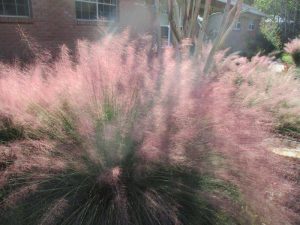
Gulf Muhly Grass in Flower. Photo credit: Larry Williams
Some drought-tolerant plants have poor tolerance to the other extreme – too much water. There are a few plants that can tolerate both extremes but they are the exception. Avoid using drought-tolerant plants on naturally wet or poorly drained sites. But if you have the typical deep sandy well drained soil Florida is famous for, you’d do well to include some drought-tolerant plants on your site.
Drought-tolerant plants are especially well suited for areas that receive little to no irrigation.
Some plants are genetically better able to withstand drought. They have a built-in tolerance of drought. Many of our Florida native plants are designed to grow in our poor water holding sandy soils. Many of the plants native to arid areas of the world possess high drought-tolerance. These plants have characteristics that allow them to better survive dry weather. These features include thicker or waxier leaves, large surface root areas or deep roots and the ability to drop leaves in drought and regain them when moisture is adequate.
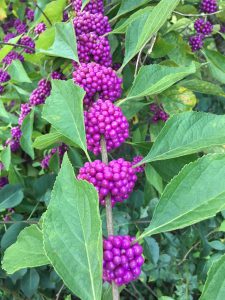
Beautyberry with fruit. Photo credit: Larry Williams
It’s important to realize that these plants must first establish a root system before they can cope with severe dry weather. Plan to irrigate during dry periods for the first season to allow them to become established.
Some outstanding trees to consider include crape myrtle, redbud, Chinese pistache, cedar (Cedrus species), hawthorn (Crataegus species), American holly, yaupon holly, Southern red cedar (Juniperus species), Live oak, Sand live oak, winged elm, pond cypress and bald cypress. Some people are surprised to learn that pond cypress and bald cypress have high drought-tolerance because these trees are associated with swamps, many times growing in standing water. But once established on a dry site, they exhibit very good drought-tolerance.
Some outstanding shrubs with drought-tolerance include glossy abelia, dwarf yaupon holly, Indian hawthorn (Rhaphiolepis species), beauty berry (Callicarpa americana), pineapple guava, junipers, oleander, spiraea, blueberry or sparkleberry (Vaccinium species), viburnum, Chaste tree (Vitex agnus-castus) and coontie (Zamia pumila).
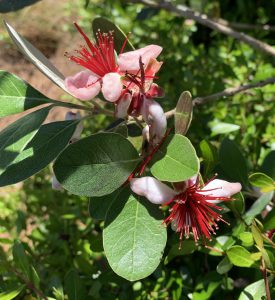
Pineapple guava in bloom. Photo credit: Larry Williams
Some outstanding drought-tolerant groundcovers to consider include beach sunflower (Helianthus debilis), daylily, juniper, lantana, liriope, rosemary (Ceratiola ericoides), Asiatic jasmine and society garlic. Many of the ornamental grasses such as Gulf muhly are good choices as well.
For more ideas on developing a Florida-friendly, water wise landscape, contact the UF/IFAS Extension Office in your County or visit the below website. https://ffl.ifas.ufl.edu/index.html

by Beth Bolles | Aug 7, 2019
We are always on the lookout for an attractive plant for our landscape. At the nursery, some plants have a more difficult time gaining our attention. They may not be as showy, possessing neither colorful flowers nor bold foliage. In these cases, we could be missing out on low maintenance plant that offers its own form of beauty in the right landscape spot.
One plant that I love is the Japanese plum yew (Cephalotaxus harringtonia), especially the spreading form ‘Prostrata’. In the nursery container, this plant is nothing special but once established in the landscape it performs well. The conifer type leaves are an attractive dark green and the ‘Prostrata’ selection is low growing to about 2 to 3 feet. An advantage too is that growth is slow so it won’t take over or require routine pruning.
Japanese plum yews grow best in partial shade and once established will be fine with rainfall. For a shadier side of the home, the spreading plum yew has a place as an evergreen foundation plant too.
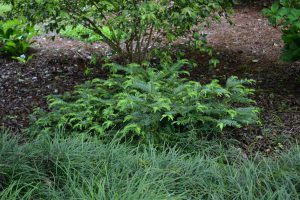
Japanese plum yew in a shaded garden. Photo by Beth Bolles, UF IFAS Extension Escambia County
If the ‘Prostrata’ selection is too low growing for you, consider the ‘Fastigiata’ cultivar that will grow upright to about 8 feet with a 5 foot spread.
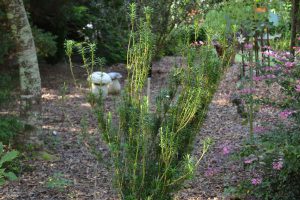
A year old planting of upright Japanese plum yew in filtered light. Photo by Beth Bolles, UF IFAS Extension Escambia County
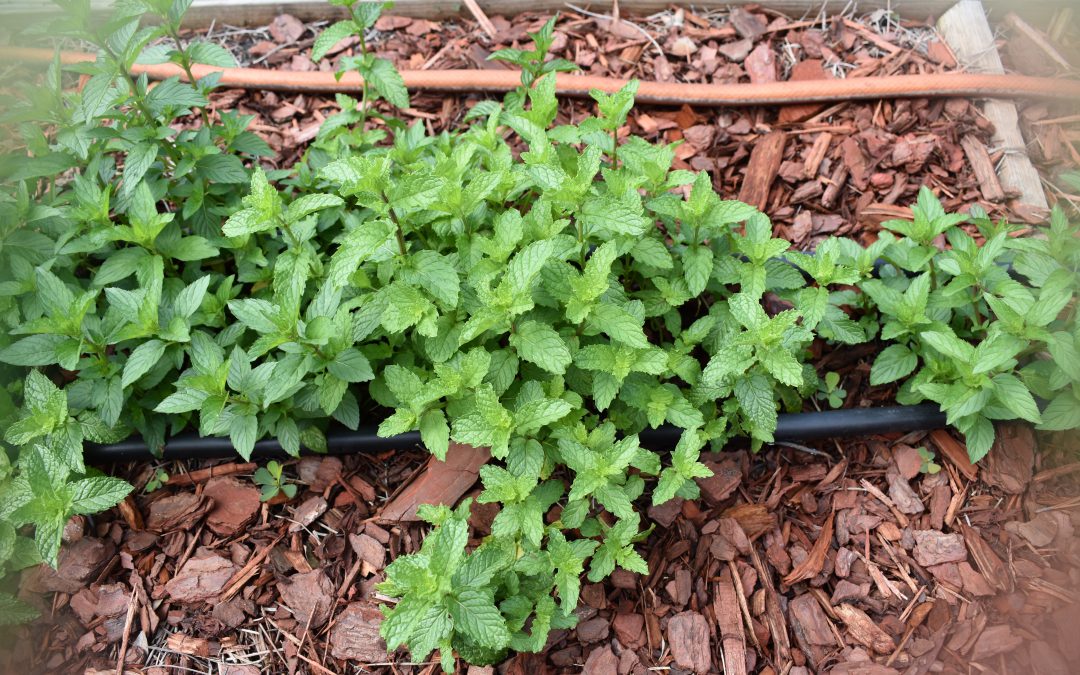
by Matthew Orwat | Jul 15, 2019
So far, the summer of 2019 has been very hot and humid. Plant heat stress was compounded due to this year’s extremely dry spring. Fortunately, there are several herbs that can tolerate drought and heat, and some even thrive on it. Here are a few herbs to think about trying this summer.
Lavender
Lavender thrives in low organic matter soils that are also well drained. Sometimes small rocks are added to the soil to improve drainage if the soil drains poorly. If the garden is mulched, make sure the mulch is several inches away from the main stem, since fungal stem rots are common in humid climates. Ed Gillman notes, in his EDIS publication FPS-337 on lavender that lavender is very sensitive to pH, and that it should be kept above 6. This is particularly noteworthy since many soils in the Florida panhandle are very acidic, at pH 5.5 or below. Lavender grows between two to three feet tall generally, but smaller cultivars exist as well. It does not respond well to excess irrigation, so make sure it is not sited next to water thirsty plants like basil. While lavender is drought and heat tolerant, a little afternoon shade during the hottest parts of summer is welcome.
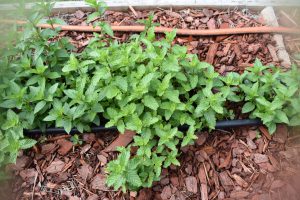
Mixed mint in raised bed, Photo by Matthew Orwat
Mint
There are many different kinds of mint available to the herb gardener, but the most common types are spearmint and peppermint. Mint thrives in the heat when well-watered and will also recover from drought conditions quickly. When planting mint, consider segregating it from other herbs, since it tends to take over any area it’s given. Raised beds are ideal for mint since the borders of a raised bed will keep it in bounds.
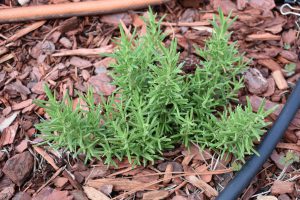
Rosemary in raised bed, Photo by Matthew Orwat
Rosemary
Like lavender, rosemary is a somewhat woody herb and can persist for several years as a “shrub” in zone 8 or higher. It is as drought tolerant as lavender and also shares its disdain for overwatering. Several cultivars exist, such as the trailing ‘Prostratus’ cultivar. Growers can expect blue to purple flowers in the winter on evergreen plants. For more information about rosemary, see this IFAS Gardening solutions entry.
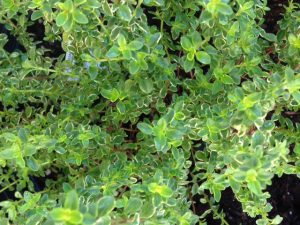
Variegated lemon thyme leaves, Photograph by Julie McConnell, UF / IFAS
Thyme
The smallest evergreen herb that does well in Northwest Florida is thyme. Thyme doesn’t like to completely dry out, but is fairly drought tolerant and excels in rock gardens, where it can cascade down over stone. It needs well drained soil to thrive and should be sited away from competition from other plants. See this Gardening Solutions page for more information
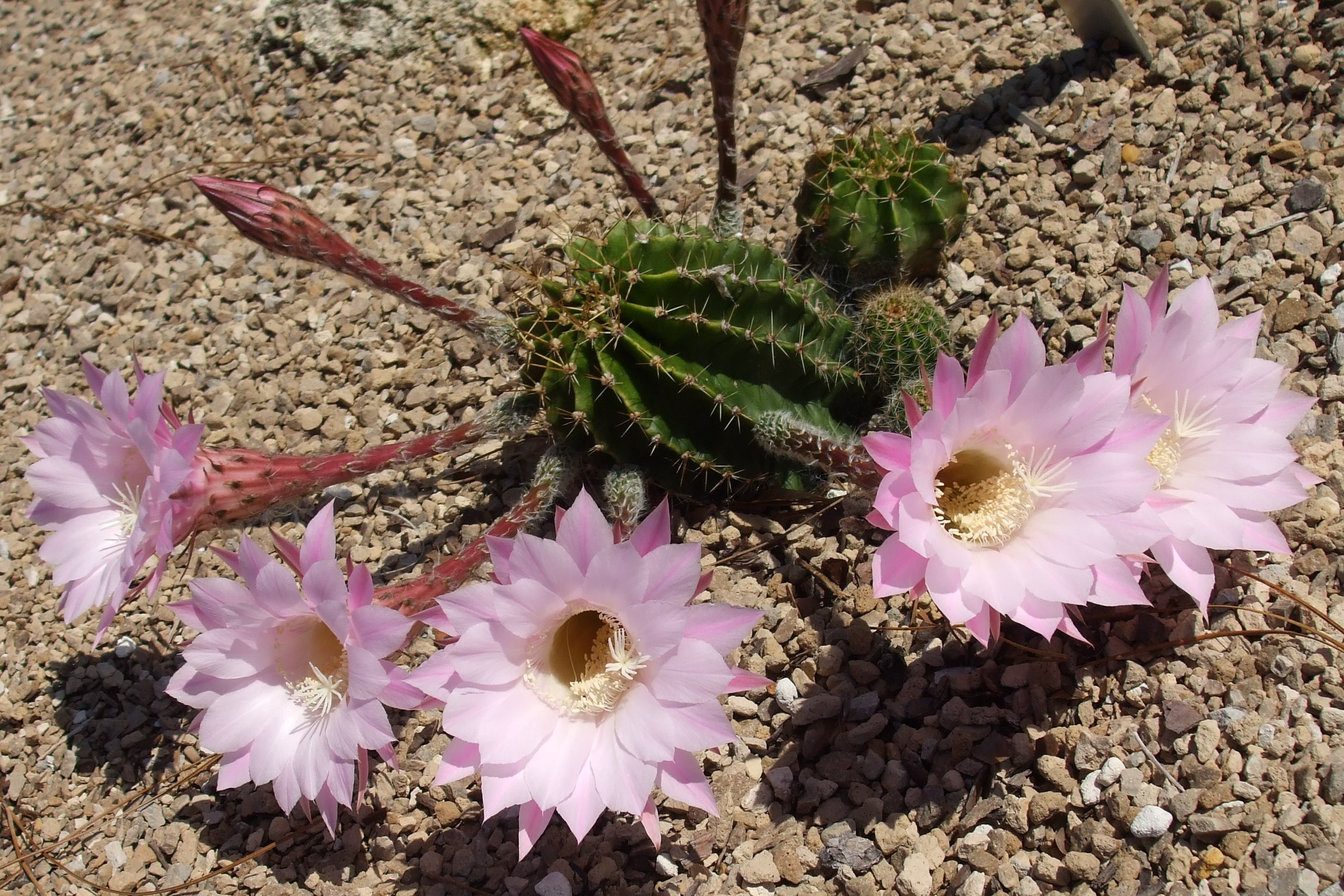
by Gary Knox | May 26, 2015
Summer is here, along with its heat, humidity, drought and stress! One easy way to garden during summer is to use succulents and other drought adapted plants.
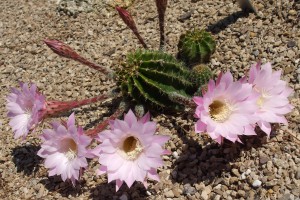
The sea urchin cactus (Echinopsis spp.) produces large, stunning flowers.
Succulents are heat-adapted, water-efficient plants often associated with deserts and dunes. Usually succulents have thick leaves or stems that store water. A cactus is a familiar type of succulent, as are agave, aloe, yucca as well as bromeliads like dyckia. Other dry-adapted plants can retreat into bulbs, rhizomes or other thick plant parts to go dormant until rains resume. A few other strategies used by plants to save water include: waxy or hairy coverings to reduce water loss; extensive root systems to absorb water; and silver- or blue-colored leaves and stems to reflect light and reduce heat.
Succulents’ tough qualities make them well-adapted to the harsh conditions of urban living amid concrete, brick, asphalt and other “hardscapes”. This adaptability translates into low maintenance since they need little or no irrigation, fertilization, pruning or spraying. Do you like container gardens? Succulents are almost the perfect container plant, because they hardly ever need watering!
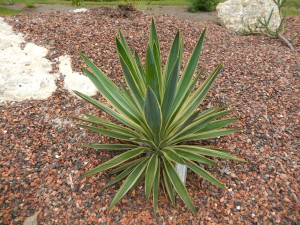
The American century plant (Agave americana) is a large growing succulent with silver-grey leaves.
Above and beyond their toughness, succulents capture our imaginations because they are often dramatic, dangerous and slightly unpredictable. Drama stems from the architectural forms of many thick-leaved plants like agave. Danger arises from the thorns and spines of plants like cactus. Unpredictability results from bulbs and perennials that can quickly explode into flower, and then disappear just as suddenly. Often succulents have outrageous flowers with wild, bold colors and strange shapes!
While many succulents are native to deserts, others are Florida natives where they can be found in coastal dunes or in areas with sandy soils that have little water-holding capacity. For example, many native yuccas are excellent succulents for use in dry gardens or in containers.
For best growth and appearance, most succulents require well-drained soil and full sun (at least 6 hours of direct sunlight per day). Succulents are ideal plants for garden beds near roads, sidewalks, driveways and south-facing walls because they tolerate limited soil moisture, higher soil pH and reflected heat and light usually associated with these areas. On the other hand, try to avoid planting succulents in shady areas, wet areas, low areas that collect water and areas with heavy soils.
Summer gardening is easy with succulents!
For more information:
Agave and Yucca: Tough Plants for Tough Times
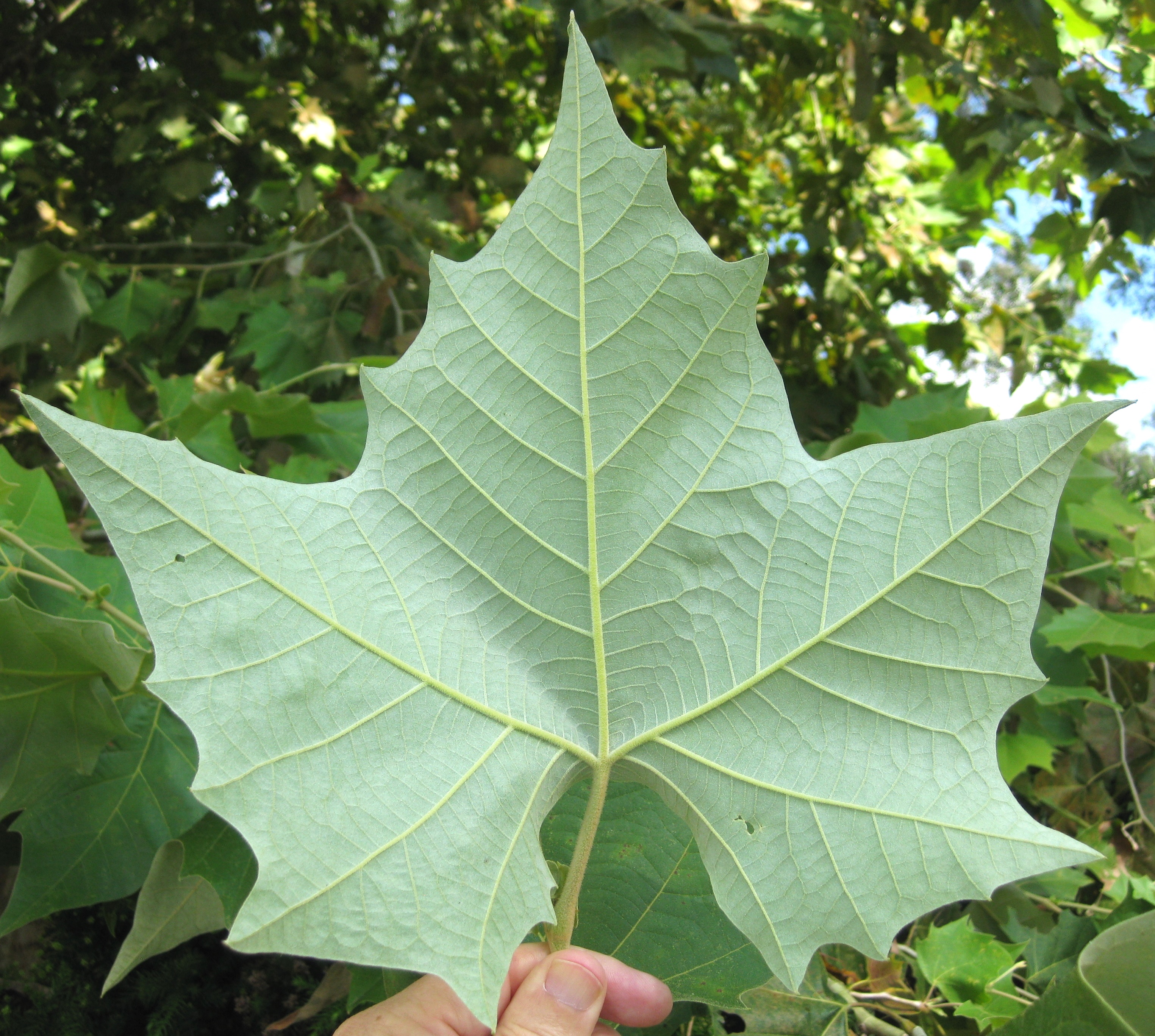
by Gary Knox | May 20, 2014
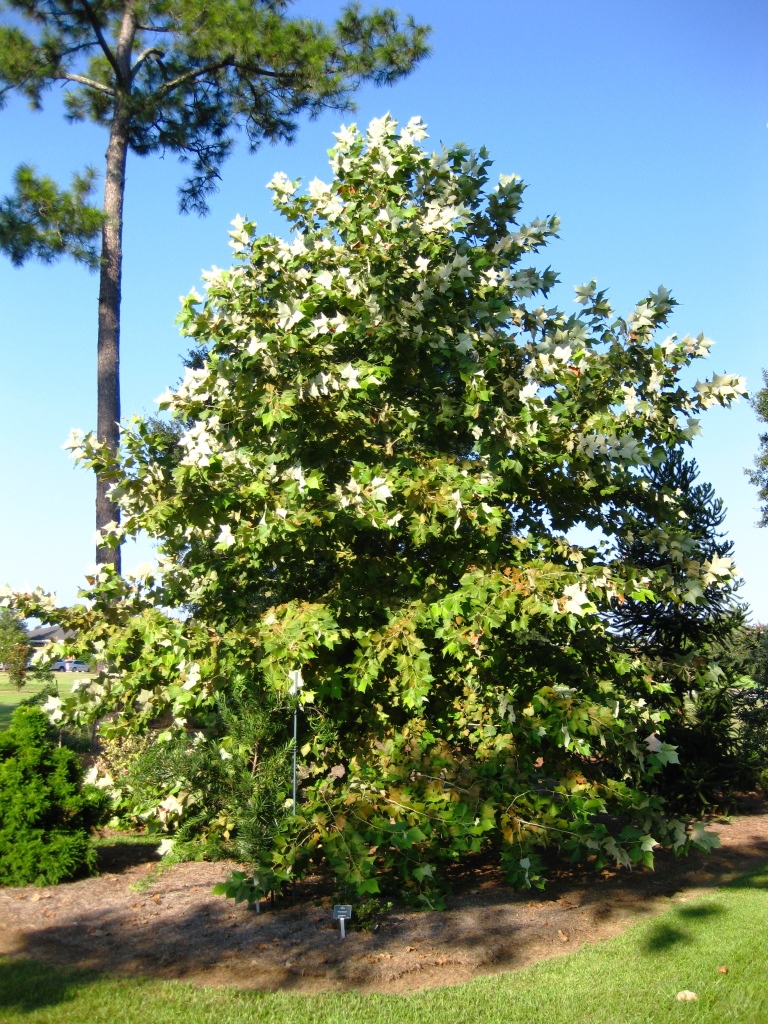
Mexican Sycamore, Platanus mexicana.
Mexican sycamore (Platanus mexicana) is a fast growing, drought tolerant tree boasting smooth white-and-tan bark and large maple-like leaves with velvety, silver undersides. Native to northeastern and central Mexico, this tree’s cold hardiness is not well defined. However, Mexican sycamore grows well as far north as USDA Cold Hardiness Zone 8b in Texas and Florida.
Mexican sycamore is slightly smaller than our native American sycamore (Platanus occidentalis). While known to grow up to 80 feet or more in the wild, Mexican sycamore typically reaches a mature height of 50 feet in the landscape with a width of about 30 feet. The tree is deciduous with an upright rounded crown. Mexican sycamore grows best in full sun and is adapted to most soils, including alkaline soils. While considered drought tolerant, best success occurs when plants are irrigated until established.
The lobed, maple-like leaves are up to 8 inches wide and olive-green, sometimes turning yellow before falling in December. Leaf undersides of mature trees (at least 4 to 6 years old) develop short, dense, whitish hairs resulting in an attractive silvery appearance. The large leaves can be a nuisance if they fall where leaves must be raked. Like the American sycamore, the aggressive roots and relatively large mature size of this tree suggest it not be used near structures and pavement or under power lines.
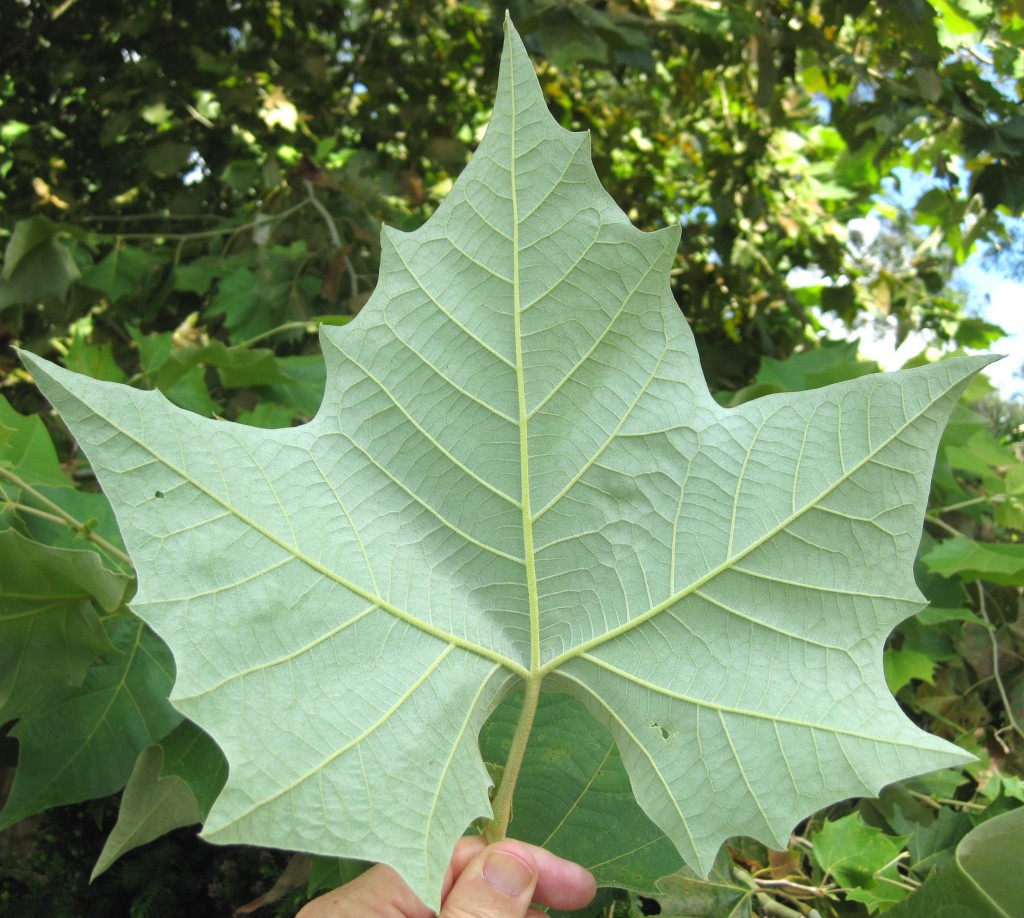
Closeup of the silvery underside of a Mexican Sycamore leaf.
Male and female flowers are borne separately on the same plant from December through February and appear as greenish balls hanging from the branches. Aggregate-like fruit about 1 1/2 inches in diameter follow in April through August.
Mexican sycamore is resistant to bacterial leaf scorch, which can be a problem on American sycamore. This bacterium causes leaves to curl and turn brown and may eventually kill American sycamore. Two occasional fungal diseases affecting Mexican sycamore are anthracnose and powdery mildew. Anthracnose causes moderate to severe leaf drop during cool, wet springs. Initial symptoms are light brown areas forming along the veins of new leaves; if severe, anthracnose can cause cankers as well as leaf drop. Powdery mildew appears as a whitish dust on leaves.
Sycamore lace bugs may feed on leaf undersides in late summer and fall. The feeding results in a stippled appearance on the top of the leaf and black spots of feces on the underside. So far, observations of this tree in Florida suggest infestations of sycamore lace bugs are not as severe as on American sycamore. Aphids may also feed on leaves; they cause little damage to the tree but exude honeydew upon which sooty mold grows and turns leaf surfaces black.
Mexican sycamore is an attractive, smaller statured alternative to American sycamore. Unfortunately, it is not commonly grown by Florida nurseries and may be difficult to find.
Platanus mexicana (Mexican sycamore) has not yet been evaluated using the IFAS Assessment of Non-Native Plants in Florida’s Natural Areas (http://plants.ifas.ufl.edu/assessment/). Without this assessment, the temporary conclusion is that P. mexicana is not a problem species at this time and may be recommended.

















